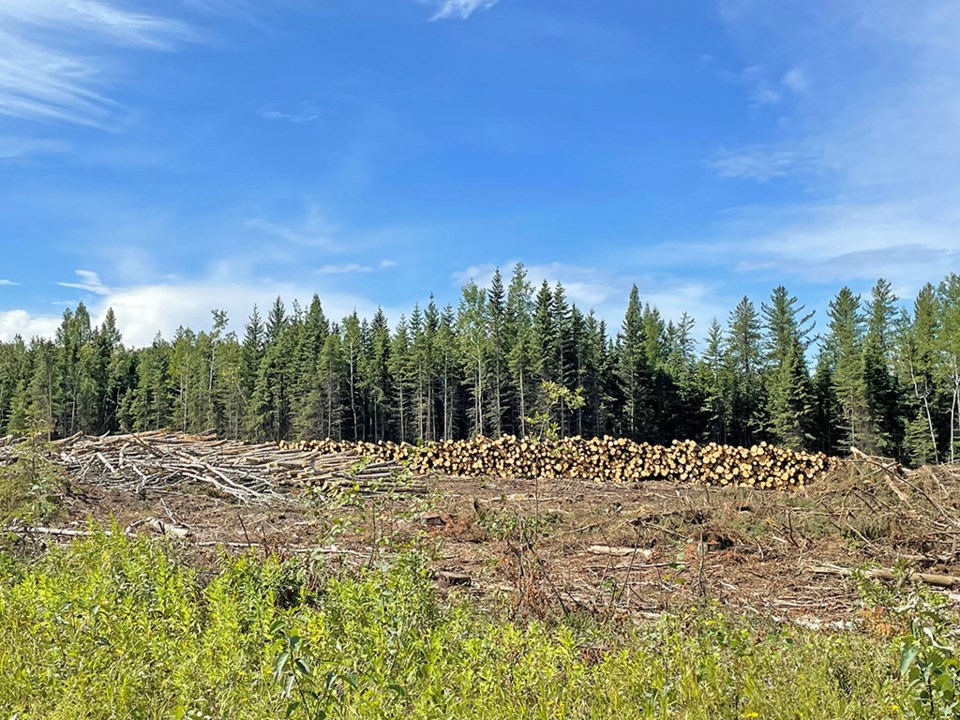CRUTWELL, Sask. — Members of the Protect our Forest group met with representatives from the province at Crutwell Community Hall on Wednesday, March 19.
The group has been protesting clear-cutting of forest around Cruttwell and Holbein, including two protests this summer in Prince Albert.
The Forest Protection Network group includes members from the Wahpeton, Sturgeon Lake, and Holbein areas, who say forests in that part of the province have important cultural value and house heritage sites along the North Saskatchewan River.
Carol Friedhoff-Nelson, a member of Metis Local 66 and a member of the Forest Protection Network in Crutwell, attended the meeting on March 19 in Crutwell Community Hall.
"We had as many members of Local 66 as we could,” Friedhoff-Nelson said. “We had a lot of our neighbours from around the area and interested people who use the forest that is up to be cut.”
The group said the area is highly important for passing culture on to the next generation. This is the area where the historic fur trade Hudson House was located, including a cemetery.
"It would be right behind Holbein,” Friedhoff-Nelson said. “There are about three or four little pockets of old-growth forests left. It's all there, and if you looked on a map, it's all kind of brown all around. There are just a few patches of green on the north side of the river. Those are what we're trying to protect.
“That is where the animals go to have their young. It's right down by the river. It's like the last little haven for so many creatures.”
Stakeholders who attended the meeting included a man who practices with his dog team in the area, people who hike and cross-country ski in the area and members of Crutwell Local No. 66 who hunt off the land.
She said her friend Linda Day, who picks wild berries for medicinal purposes, was also in attendance, as was Candace Campbell, whose father Herman had a trap line in the area before he passed away.
"It was good, at the meeting, to hear so many stakeholders,” Friedhoff-Nelson said.
Friedhoff-Nelson said she understands the economic benefits of the clear-cutting for jobs but the way they are cutting is not in a sustainable manner.
She said the way the trees are being replaced is not like a fire, where all plant life returns after the fire and the trees are replaced by a single type of tree.
“Their science says they are just mimicking a forest fire because that's what they're going to protect us from,” she said.
"When they go through clear-cutting, everything is destroyed, everything is destroyed, and then they churn up the land, and they come back in a few years and they plant one kind of tree. They call it a forest, but it's a monoculture plantation,” she added.
"We've seen the devastation in behind Crutwell. We used to have a big beautiful forest there, too. A lot of the neighbours are worried about the drought, irrigation problems, land, and soil loss. With the drought that we have, things will just blow away. They call it the island forest because our area is a fragile ecosystem growing on sand, so when they removed the trees, it's hard for anything else to grow.
According to Friedhoff-Nelson, there were four people from forestry representatives from the provincial government present at the meeting. She said most of the people they have dealt with over the last two years are gone, and the new people were not present for previous discussions.
“That's why we're trying to get everybody who uses the forest (involved),” Friedhoff-Nelson said. “We're all saying, no, no, don't cut. Leave something standing.
“We just want our forest to stand,” she added. “We just want it there.”
Friedhoff-Nelson said they’ve had fires come through before and are prepared to deal with it. For her, keeping the forest the way it is has personal meaning.
"My heart is in it and my soul,” she said. “My daughter has walked those forests all of her life with my grandchildren. They were out there, too, in the Bush. They were cutting teepee poles out there. Now it's my great-grandchildren. There won't be anything to go to.
She also pointed to archeologists working near Sturgeon Lake First Nation north of Prince Albert saying findings at a site that show evidence of long-term settlement in the area.
In a press release on Feb. 3, archeologists said the site shows signs of being a permanent settlement, and not a temporary hunting camp. Findings include stone tools, fire pits, and lithic materials used in toolmaking. The site also includes bison remains, which provide insight into early hunting techniques, and the evolution of the species. There is also evidence the inhabitants practiced fire management.
"We've got to protect the forest to protect the land so we can get in there and check our history out, because once the machines go in there, it's gone. It's going to be trampled and smashed, so there are a lot of irons in the fire here—a lot of things going on.”
She said the group from Metis Local 66 and the Protect Our Forest have a message that saving the land around Holbein and Crutwell is also part of reconciliation.
"How are we to pass it on like we're supposed to be able to, to teach our history and our culture and who we are to our children and our grandchildren? How do we teach them when the classrooms are being destroyed, when they're being sold?”
The Ministry of Environment previously stopped plans to clear cut trees in the Holbein and Crutwell areas northwest of Prince Albert in January.
UPDATE: Ministry of Environment confirms meeting and request for three-year moratorium
After the print deadline for the Daily Herald Rural Roots edition, the Ministry of the Environment responded to the Daily Herald’s request for comment.
The Ministry confirmed that a meeting took place on March 19 between the Ministry of Environment and the Crutwell Métis Local regarding proposed 2025/2026 and 2026/2027 Forest Harvest Design and Reforestation Activities for the Island Forests Timber Supply Area as part of its Duty to Consult process.
The Ministry said that at the meeting, the Crutwell Métis Local requested a three-year moratorium on logging in three specific areas.
“The ministry staff in attendance committed to taking all feedback, including the moratorium request, back to be considered during its review period, which is still ongoing,” the statement read.
They explained that in the absence of a single large forest licensee, the Ministry of Environment is responsible for long-term forest management planning, high-level operational plans, and forest renewal for the Island Forest.
“Public engagement is an important part of each level of planning. The ministry welcomes all input, including traditional knowledge and local information about the potential impact of the proposed plans, as they are developed. The Government of Saskatchewan is committed to fulfilling its legal duty to consult with First Nation and Métis communities before making decisions that may affect the exercise of Treaty or Aboriginal rights, following the government’s consultation policy framework,” the statement reads.
The ministry stated that their overall goal is to maintain the long-term health and sustainability of Saskatchewan’s forests, balancing economic, ecological and social considerations.




